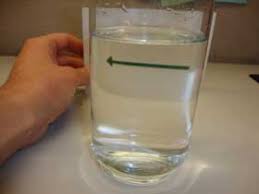An arrow mark is supposed to show us the right way. An arrow pointed towards right implies that we need to move to our right. But what happens when arrows start tricking us? Well, then we should understand how they do it. This simple and interesting reversing arrow experiment will help us understand the concept of refraction of light in water.

Materials required
Transparent plain glass – 1 (without any designs or cuts)
Water – Enough to fill the glass
White paper – 1
Marker – 1
Steps to follow
- Using the marker, draw a thick arrow mark on the sheet of white paper.
- Hold the paper upright. You can take the help of some family member for this.
- While holding the paper, see that the arrow is pointed towards the right.
- Keep the glass in front of the paper. There should be a little distance between the paper and the glass.
- Look at the arrow through the glass. Do you see any change? No.
- Now fill the glass with water.
- Look at the arrow once again, through the glass filled with water.
- What do you observe? The arrow that was pointed towards the right is now pointing to the left. Magic created!
What we learn
Did the arrow really turn around when it saw water placed in front? No, this is far from magic. Arrow didn’t turn sides. It just created an illusion that it turned. We can explain this reversal of arrow with the help of a simple concept of physics, known as refraction.
Refraction is the tendency of light to deflect or bend, when passing from one medium to another with a different density. In our reversing water experiment, light passed through the mediums of glass, water, and air, before it ultimately touched the arrow.
What exactly happened when there was water inside the glass? Water and the curved glass together produced properties equivalent to that of a magnifying lens. Do you know what happens when a beam of light passes through a magnifying glass? Magnifying glasses are actually convex lenses. Its special properties force light rays to converge at a point called focal point. When the rays go beyond this point, they bend and travel in the opposite direction.
So beyond the focal point, the rays which were on the left side will appear on the right, and those which were on the right appear on the left. This is why the arrow turned exactly opposite. This effect was possible only when the glass was filled with water. This explains the illusion of reverse arrows.
Check our Experiments section to try more such interesting experiments.
Here’s Something You Might Like
As a participant in the Amazon Associates Program, Science4Kids may earn from qualifying purchases.




